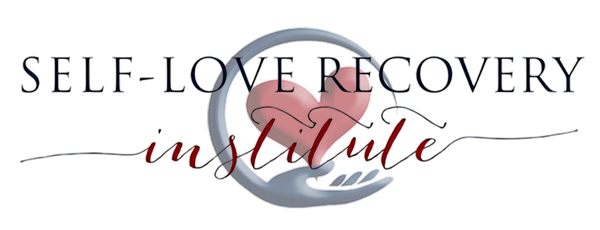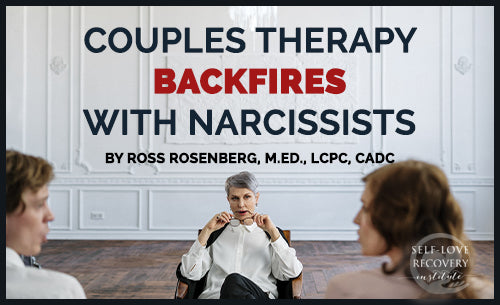
Written by Ross Rosenberg, M.Ed., LCPC, CADC
Self-Love Recovery Institute — President/CEO
Psychotherapist, Educator, Author, Expert Witness
In my 35 years in the psychotherapy field, including my experiences as a marriage and couple therapist, I wholeheartedly support this type of clinical intervention. Moreover, I have personally experienced the value of good couples therapy, and unfortunately, bad. Successful couples therapy outcomes require both clients to be able and motivated to accept responsibility for both their individual and relationship problems, as identified through the therapy process. Also needed is a shared willingness to arrive at a “middle ground” position where some form or level of compromise is safely considered.
THE NECESSARY INGREDIENTS
For a successful outcome of couples therapy, there must be a shared will and desire to reach and sustain a relationship “détente” to relax the buildup of tension, hostility, and perceived victimization. With the above conditions, the revival of the “original” sympathy, empathy, and unconditional love is almost always revived and sustained long enough for the couples’ therapist to facilitate an agreed-upon and supported positive outcome. Unfortunately, when one or both partners are unable or unwilling to learn, grow, compromise, and experience the necessary empathy or sympathy, couples therapy intervention almost always fails.
It is extremely likely that couples therapy will fail when one of the partners has been or could be diagnosed with narcissistic (NPD), borderline (BPD), and antisocial (ASPD) personality disorder. In my book, The Human Magnet Syndrome: The Codependent-Narcissist Trap I refer to these three personality disorders as pathological narcissism, a group of mental health disorders that, despite having distinctly different impaired personality profiles, share permanently embedded narcissistic personality traits.
To different degrees and manners of expression, individuals fitting the diagnostic profile for NPD, BPD, and ASPD, are selfish, egocentric, and grandiose, while having limited judgment for right or wrong and limited ability to experience empathy and remorse. In addition, most pathological narcissists are demanding, entitled, controlling, and reactively and punitively angry when confronted or challenged. Such narcissists are only empathetic or sensitive to others when doing so results in a tangible reward for themselves or when it makes them feel valued, important, and appreciated.
You may wonder why the pathological narcissist would even agree to go to marriage therapy in the first place. It is most likely because they have an ulterior motive. They want the therapist to side with them to reaffirm their partner’s gaslit beliefs that they are the problem, not them. They are happy to explain their version of events that occurred in the relationship, while cheerfully criticizing their partner’s flaws and coming up with endless excuses for their own negative actions. When it is the SLD’s turn to speak, should they decide to, the narcissist is faced with the impossible task of accepting constructive feedback and criticism, which often results in a narcissistic injury.
ON THE OTHER HAND
A person with the “complementary” and oppositely compatible[i] mental health condition known as codependency, or by its updated term, self-love deficit disorder™ or SLDD, is equally unable to achieve positive outcomes in couples therapy. The difference between pathological narcissists and those with SLDD—a self-love deficient or SLD—is that SLDs are capable and motivated for growth and change and possess the mental capacity for empathy and remorse. However, they not being able to communicate their authentic feelings and reactions to harm and are compromised by their inability to set boundaries and limits on most people, especially a pathologically narcissistic loved one.
NARCISSISTIC INJURIES
As will be discussed in the remainder of this article, couples therapy cannot work with a combination of a pathological narcissist and an SLD. In fact, it is an accident waiting to happen. Narcissistic partners often quit couples therapy when held accountable for their harmful treatment of their partner and react with narcissistic injuries. A narcissistic injury occurs when narcissists reflexively react to perceived criticism, embarrassment, judgment, boundaries, or attempts to be held accountable. Often, such a reaction takes the shape of aggravated anger or rage, a compulsion to retaliate immediately, or a covert strategy to mute the rage while planning for a better opportunity to punish and retaliate.
Such reactive fits of punitive rage also occur when the partner and/or therapist does not accommodate a narcissist’s insatiable need for admiration, special privileges, and praise. In the case of a person with borderline personality disorder (BPD), the narcissistic injury shows up when the perceived wrong-doing or insensitivity is over-amplified. At the same time, paranoid-like thought processes drive the need to believe malicious or purposeful intent.
TRIANGULATION
Many therapists are not equipped with the knowledge, experience, or expertise to deal with pathological narcissists, which can often result in the well-intended therapist beginning to triangulate or side with the narcissist—and that is a huge problem. When this happens, the therapist often accidentally traumatizes the SLD client, while reinforcing the narcissist’s distorted beliefs or manipulations. As a result, the therapist has now empowered and enabled the narcissist, who then weaponizes the therapy session(s) to use as proof that they are right—while demeaning, harming, and gaslighting their SLD partner.
In these couples therapy sessions, the therapist spends an ordinate amount of time trying to calm the narcissist, trying to get them to see it objectively and neutrally so that they can find a common ground to address a problem—and that's extremely difficult, and at times, impossible. And in this process, you've devoted most of the session not fully involving the SLD client, leaving them feeling small, demoralized, or marginalized, which is illustrative of their experience with life in the marriage.
PROJECTION
The defense mechanism known as “projection” invisibly and unconsciously protects the narcissist from understanding their true shame-dominated and self-hating selves. As an unconscious/dissociated defensive strategy, it conveniently shifts, places, and diverts all of what the narcissist hates about themselves—which is too painful and unsafe to recollect—onto the person they misperceived as hurting them. Projection also explains the inner workings of a narcissistic injury. Narcissists project their self-hatred, self-judgment, and unexpressed rage over their unmitigated abuse as a child, onto a safer person—the offending and supposedly injuring person.
Through the projection or placement of such untapped vindictive rage onto another vulnerable person, they delude themselves as finally being strong enough to stand up to their enemies, which are really themselves and the result of their childhood trauma. Blaming and punishing others “successfully” protects them from what their fragile minds cannot accept. Feeling bad, broken, and never good enough, as they felt as a child, is not an option for the personality-disordered narcissist.
Hence, in couples therapy, they obliviously blame their partner and therapist for their own problems, without the capacity to understand the twisted truth of their actions. For example, it is common for the activated narcissist to refer to the couple’s therapist as “stupid, opinionated, they don't listen, they're taking your side.” When the therapist does not back down, this often results in projection and narcissistic injuries, many of which are postponed and to be delivered to the SLD partner after the session, where the pathological narcissist cannot be observed by others. In such cases, the combination of projection and a narcissistic injury creates an immediate or postponed strategy to either punish the SLD into submission or terminate the therapy sessions.
Therefore, it is logical to conclude that because of the pathological narcissist’s personality disorder, and their natural inability to openly, honestly, and safely participate in a mutual therapeutic process that relies on shared responsibility, couples therapy is most definitely not recommended, and, in fact, potentially dangerous for their self-love deficient partner.


0 comments